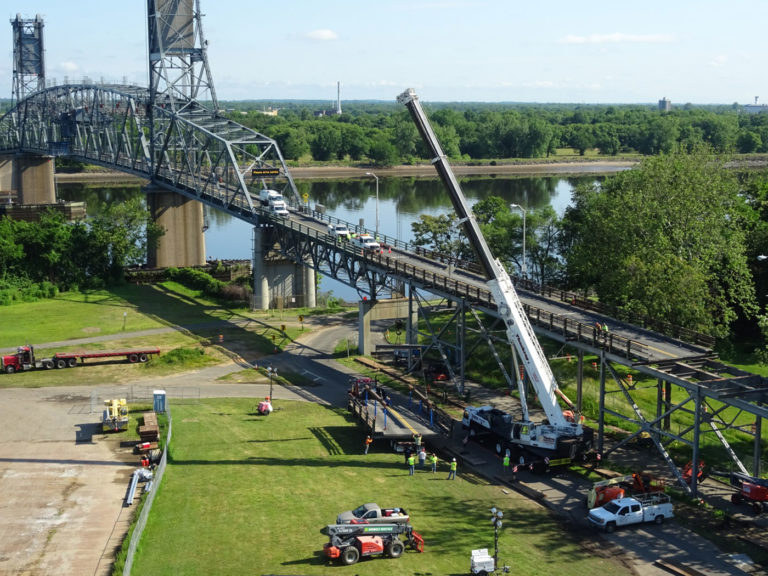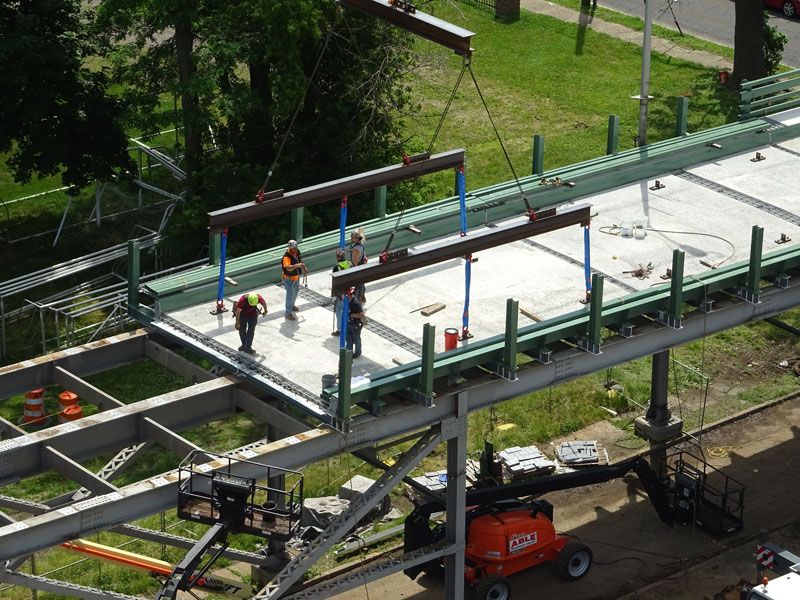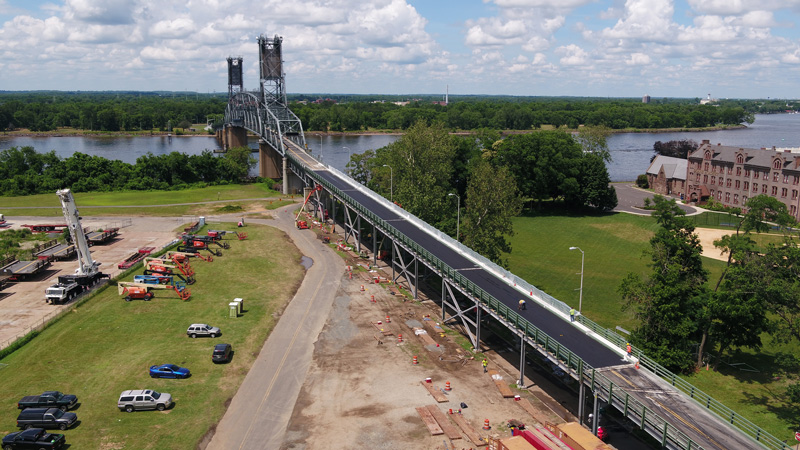Sustaining Our Bridges: Taking Advantage of Captured Time

Burlington-Bristol Bridge
The Burlington-Bristol Bridge is a steel-member, truss bridge with a vertical lift span. It crosses the Delaware River via Route 413 connecting the City of Burlington in New Jersey to the Borough of Bristol on the Pennsylvania side. Built in May 1931, the bridge is situated between the Tacony-Palmyra Bridge (downstream) and the Delaware River-Turnpike Toll Bridge which sits upstream. Constructed of steel, the total length of the bridge is 2,301 feet (701.3 m), 20 feet (6.1 m) wide. The longest span is 540 feet (165 m). The lift span is 61 ft. high when closed at mean high water. It raises to 135-foot to allow large vessels to navigate the Delaware River.
Project Program
As part of the Burlington County Bridge Commission’s (BCBC) five-year capital improvement plan, the deck structure (viaduct) leading to the bridge span on the New Jersey side of the bridge was scheduled for replacement. The Bridge is a 2-lane crossing. In a perfect world, the estimated time for repairs was about 30 overnight closures. That means closing both lanes and working only at night. However, due to weather or other unforeseen conditions, those 30 nights might not occur in succession. Closing only one lane would have subjected the steel-framed viaduct structure to vibrations caused by passing trucks which could also slow down the process.
Working within these parameters with live traffic is the norm for roadway workers and comes with a mitigated risk. In addition, every time a work crew enters or exits a traffic zone to perform the work, including the set-up and break-down of traffic protection, it poses additional risk to their safety.
Rethinking the Plan

Lighter than usual traffic patterns caused by the COVID-19 pandemic and the New Jersey Governor’s executive order mandating citizens to stay-at-home created a unique window of opportunity for the BCBC to rethink the project program. Taking full advantage of the situation, the BCBC approved completely closing-down the bridge for the shortest amount of time possible. This decision would maintain project continuity and increase worker safety. It also would cause the least amount of traffic disruption and inconvenience to the travelling public. On Thursday night June 18, 2020 the Bridge was closed for four consecutive days and nights. This time envelope also had a better potential success rate. Projected weather reports for only four consecutive days are more reliable than scoping out longer periods. The construction would continue through Sunday June 21st, with a scheduled re-opening on Monday morning.
Deck-off Staging
Faced with new parameters, Cornell & Company Inc., BCBC and Colliers Engineering & Design, hired to oversee the construction engineering and inspection process, collaborated to completely re-think and coordinate the project orchestration. The overall program consisted of the removal of all the 40-foot deck sections on the viaduct on the south side bridge approach. The existing decks were methodically removed from the beginning of the viaduct in a south to north direction, toward the bridge tower span. Once the deck removal process was far enough ahead, it created a pre-established safety zone. This was big enough for two cranes to safely function independently. Then, the new deck installation commenced following the same south to north path. This staging enabled two separate operational zones to function simultaneously, lifting decks on and lifting decks off, both toward the same goal. Once this tempo was established, the job progressed like clockwork.
Deck-on

Assembled off-site, the new prefabricated steel-member decks were surfaced with a pre-cast concrete. This created a sub-flooring prepared to accept the eventual asphalt layer. Once moved to the job site, the decks were systematically stored and placed in unison next to the bridge. Rebar and sidewalks were then installed. Once lifted, positioned and secured on the viaduct, steel side rails were installed. Concrete was also applied to the non-expanding joints to keep the slabs together. After all decks were in place, a tack coat to make the asphalt adhere better was installed. The asphalt was laid in tandem echelon formation and completed with traffic striping.
As a result of a previous drone inspection using high-resolution imagery flown by Colliers Engineering & Design’s UAS Division, while the deck structure was open, other repairs were made to the upper and lower sections of Pier 8, one of the main bridge supports and the cleaning and painting of all existing steel members.
Conclusion
As most people freely drive over a bridge any time during the day or night, they aren’t thinking about the immeasurable effort it takes to keep our critical infrastructure safe and viable for everyone to use. Which is exactly as it should be. While the COVID pandemic wreaked havoc on the health and welfare of our global populations, it conversely created a window of opportunity for the Bridge Commission. These timely, proactive determinations to facilitate this project’s timeline that proved to be in everyone’s best interest.
Not only was the project’s progression seamless, it was completed ahead of the anticipated timeframe by half-a-day. The Bridge was completely re-opened by about 6pm Sunday evening.
